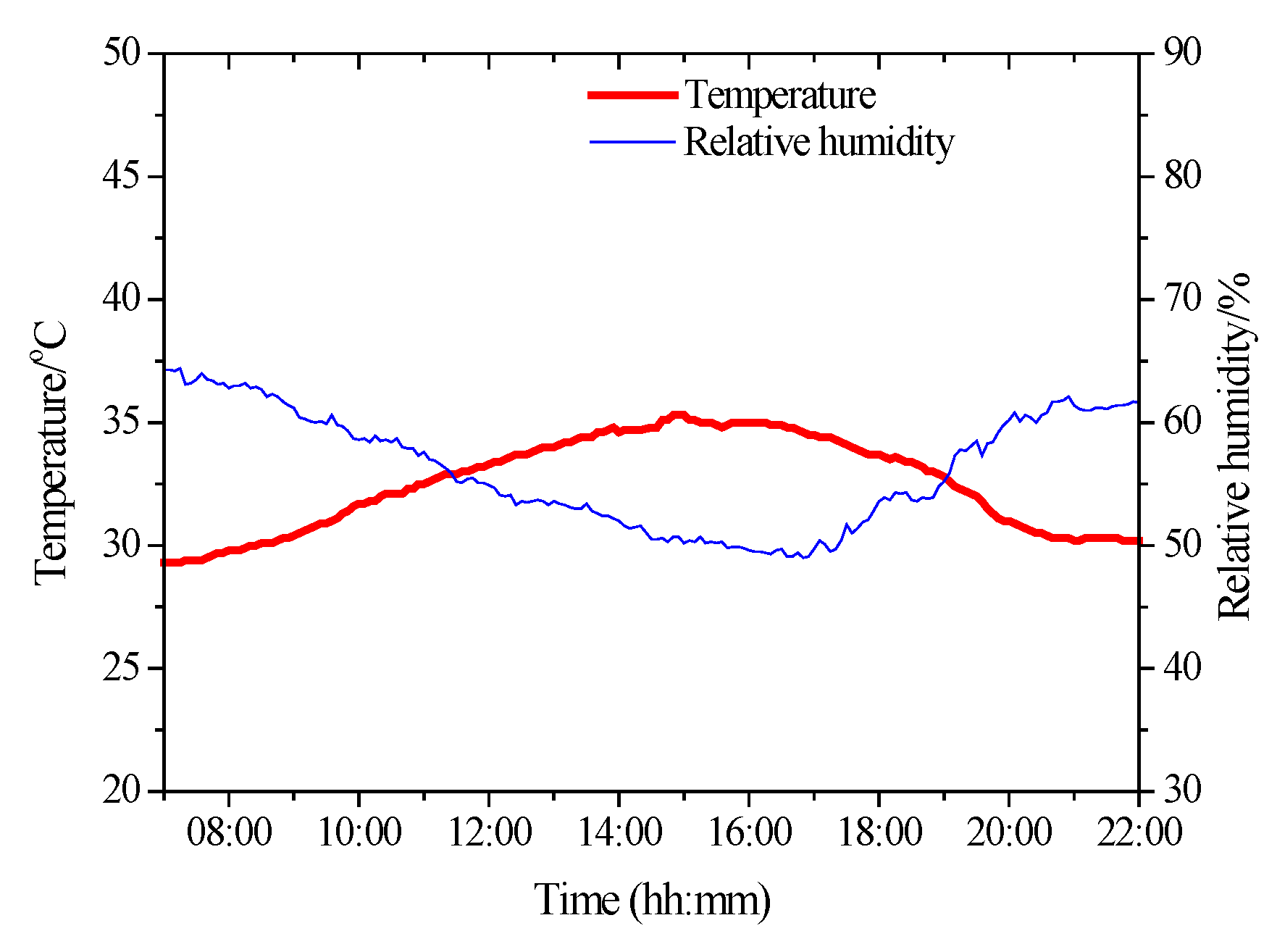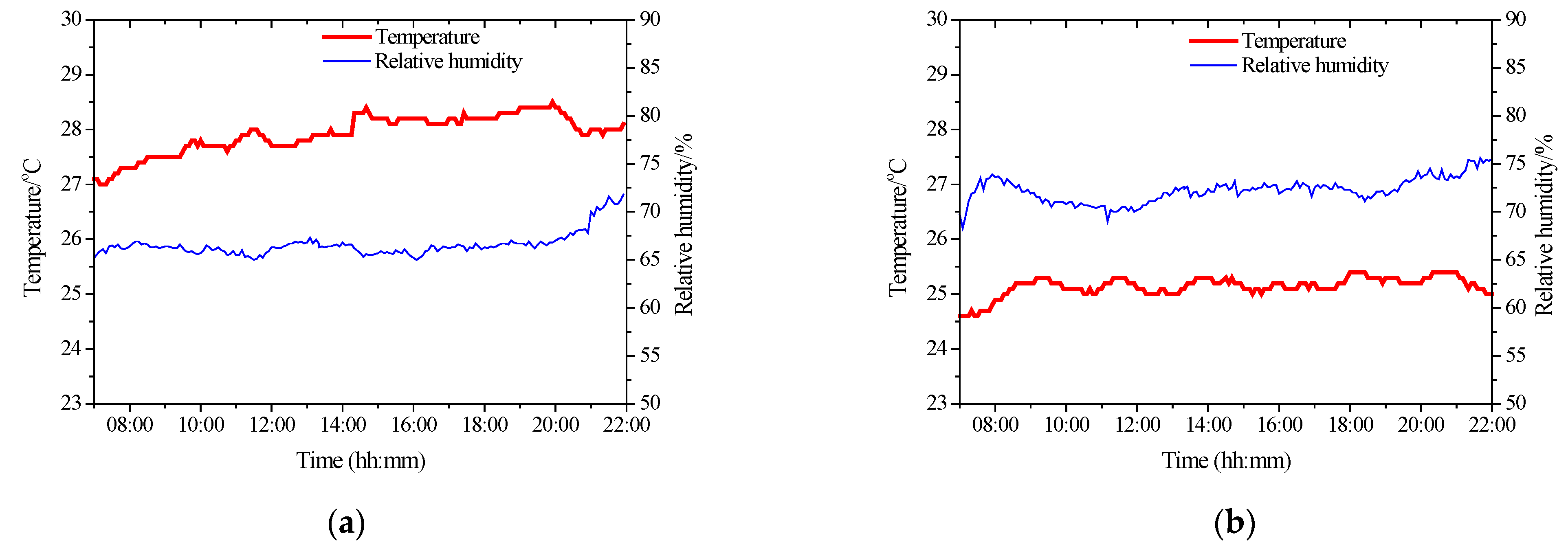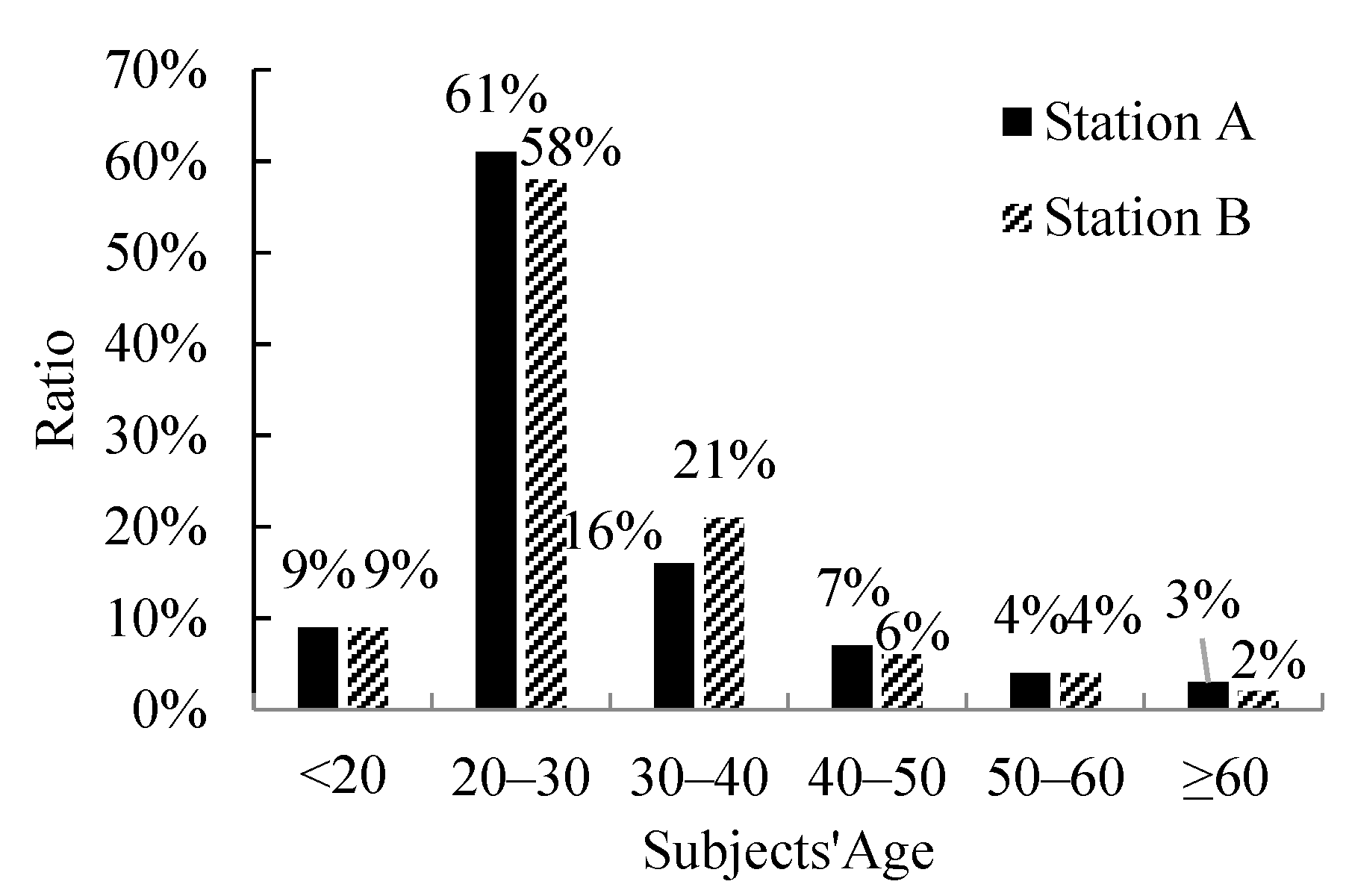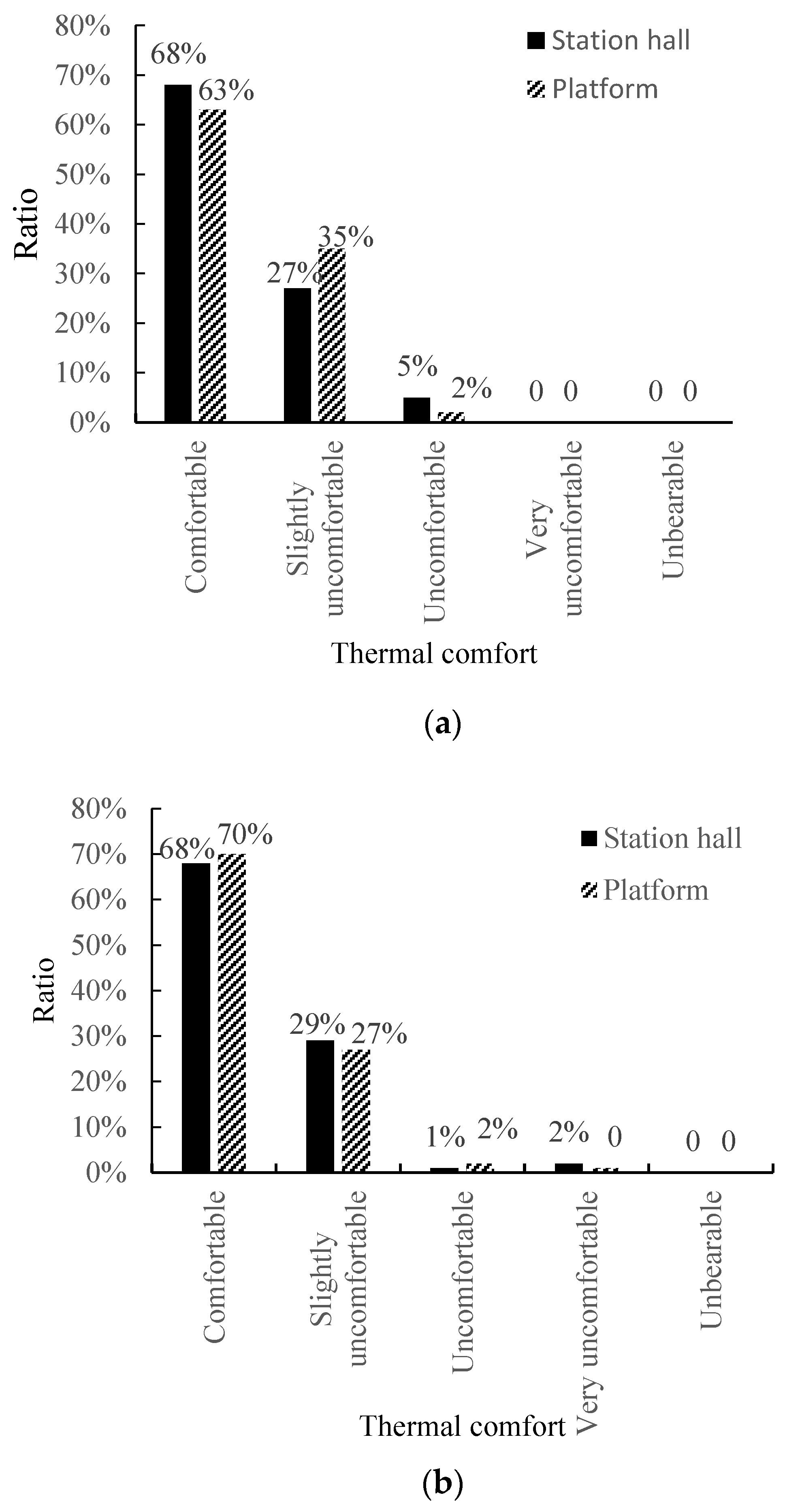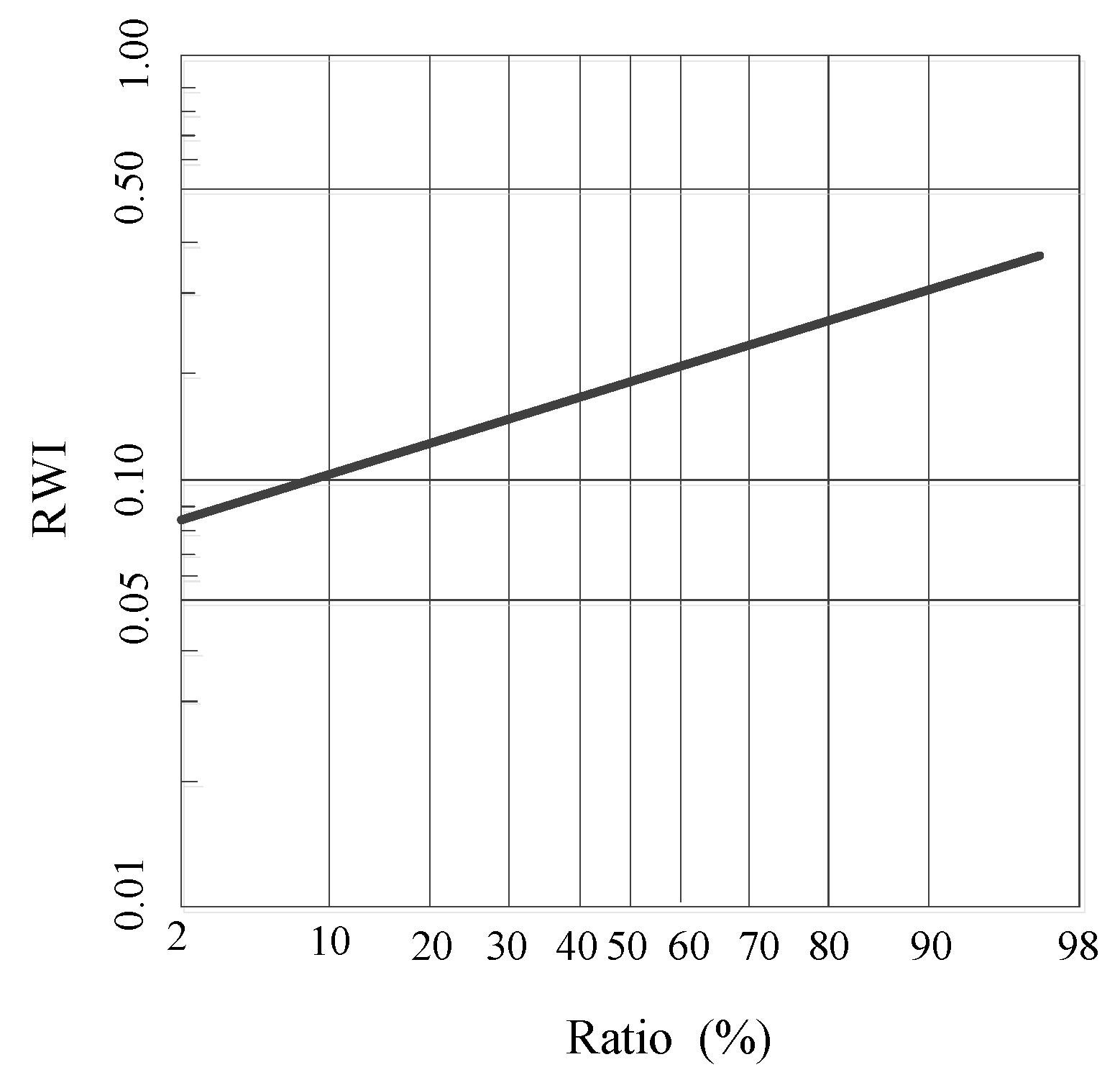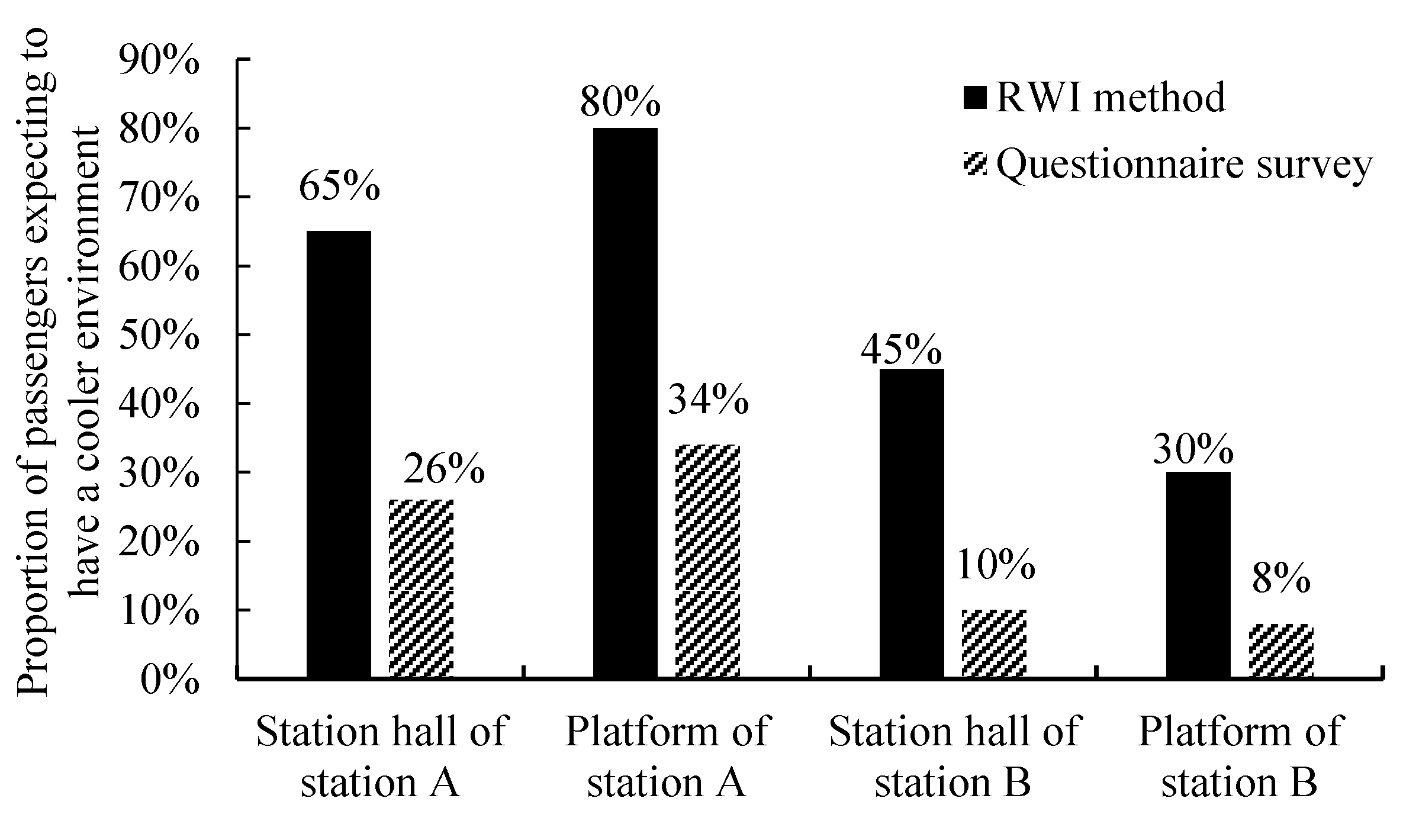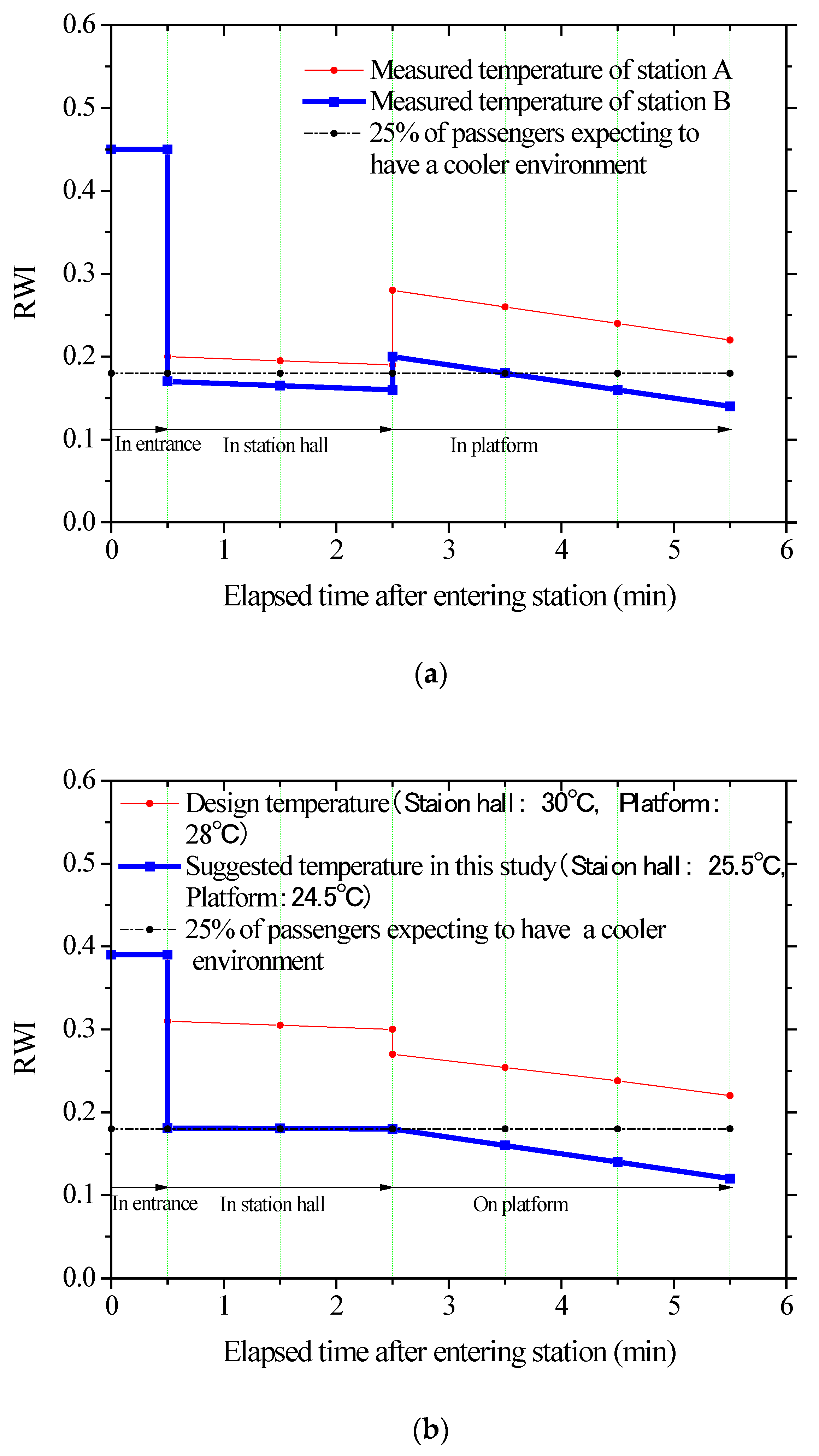1. Introduction
With the rapid development of urban rail transit, subways have been vigorously constructed by the government and widely used by people by the virtue of their safety, efficiency, environmental protection, and large passenger capacity. A subway station is an underground space for personnel turnover, and its thermal environment directly affects passengers’ thermal comfort. According to incomplete statistics in China, the subway runs for 15 to 20 h a day in different cities [
1]. Most passengers take the subway two times a day or more [
2]. Passengers’ dwell time in the station hall ranges from 1 to 10 min. Passengers’ dwell time on the station platform ranges from 2 to 6 min [
3]. The thermal environment in subway stations is closely related to the quality of life.
In the design of subway engineering, the ventilation and air-conditioning system is an essential part of the whole subway engineering, not only providing a comfortable environment for passengers but also necessary environmental conditions for the operation of subway trains and equipment [
4]. The development of rail transit alleviates the traffic pressure in the process of urbanization to a certain extent; however, the energy consumption during its operation is quite astonishing. The energy consumption of subway operations mainly involves electricity used for traction and ventilation and air-conditioning system electricity [
5]. According to statistics, the energy consumption of ventilation and air-conditioning system accounts for about 30–50% of the total energy consumption of the entire subway station [
6,
7,
8]. Approximately 50% of the energy consumption of subway operations in southern Chinese cities is the energy consumption of the ventilation and air-conditioning system, and the energy consumption of ventilation and air-conditioning systems in northern Chinese cities also reaches 1/3rd of the total energy consumption in subway operations [
9,
10,
11]. Zhao [
12] took Zhongjiekou Station of Wuhan Subway Line 2 in China as the research object and used EnergyPlus to establish a simplified physical model of the station and a model of ventilation and air-conditioning systems, simulating the annual energy consumption of subway stations. The results show that the energy consumption of ventilation and air-conditioning systems accounts for about 46% of the total energy consumption of subway stations. The standard of indoor air design temperature for air-conditioning directly affects the designed load of the air-conditioning system, which in turn affects the initial investment, energy consumption, and operational cost of the environmental control system of the subway station. Therefore, rationally setting the indoor air design temperature standard for air-conditioning in subway stations can provide passengers with a comfortable thermal environment and achieve the goal of saving investment and energy.
The determination of indoor air design parameters for comfort air-conditioning is usually based on the thermal comfort requirements of occupants. The most widely used thermal comfort evaluation indices are the predicted mean vote (PMV) and predicted percentage of dissatisfied (PPD) indices [
13]. The PMV is an index that predicts the mean value of the votes of a large group of persons on the 7-point thermal sensation scale. The PPD is an index that establishes a quantitative prediction of the percentage of thermally dissatisfied people determined by PMV. The international thermal comfort standard ISO7730 proposes the level standards of thermal comfort in the comfort range with PMV as an index. It divides the desired thermal environment for any space into three categories, A (0.2 < PMV < +0.2), B (0.5 < PMV < +0.5), and C (0.7 < PMV < +0.7), where Category A has the highest level of thermal comfort [
13]. Based on the thermal comfort level requirements of the space, the indoor air design parameters of the space can be determined. The thermal comfort level based on PMV is adopted by many thermal comfort standards and air-conditioning design standards to determine the acceptable thermal environment and indoor air design parameters. For example, the ASHRAE thermal comfort zone is determined by the PMV range of Category B comfort level [
14].
However, the PMV index is suitable for the thermal comfort evaluation of occupants in steady-state thermal environments, but not for dynamic thermal environments. A subway station is a transitional space for passengers to stay for a short time while waiting. It connects two spaces with different thermal environment parameters such as temperature and humidity. The thermal sensations of passengers in this space when they stay there for a short time and change their activity states are different from those when they stay stationary for a long time in the same space. Therefore, passengers’ requirements for thermal comfort environment parameters of the subway station greatly differ from those of non-transitional space. The indoor air design parameters and the determination methods for a steady thermal environment of conventional buildings such as office buildings, residential buildings, and commercial buildings are not applicable to subway stations [
15,
16].
Therefore, it is necessary to propose the thermal comfort index of the human body to this type of transition space to guide the determination of the air-conditioning design parameters of this type of space. Subway construction in European and American countries started earlier, and research on thermal comfort standards for subway stations has also been investigated earlier. For the thermal environment of subway stations in summer, on the basis of the theory of the relative strain index derived by Lee and Henschel [
17], and in combination with the experimental results on comfort tests sponsored by the American Society of Heating, Refrigerating, and Air-conditioning Engineers (ASHRAE), the US Department of Transportation proposed the relative warmth index (RWI) to evaluate passengers’ thermal comfort in subway environment and determine the indoor design conditions for air-conditioning in subway stations and trains [
18]. In China, subway construction started in 1967, and in recent years, it has developed rapidly. Studies on the standards for thermal environments in subway stations were also carried out successively. In 2002, Fan et al. [
19] used the RWI method to calculate the RWI values for the designed temperature in the existing subway stations in large cities in China (Beijing, Shanghai, Nanjing, Guangzhou, Shenzhen, and Chongqing). They also discussed the designed temperature and concluded that the design temperature in the station hall should be at least 1.7 °C lower than that of the outdoors. In the same year, Wang et al. [
20] took the subway stations to be constructed in Chengdu as the research object and calculated the variation laws for the RWI values of passengers in the process of entering and leaving the station. They found that if the designed temperatures in the hall and platform of the Chengdu subway stations were designed according to the Code for Design of Subway (GB 50157-92) [
21], most passengers would feel uncomfortable. Therefore, it is suggested that the temperature differences between the station hall and outdoors should be increased. In the same year, Liu et al. [
22] used the RWI method to evaluate and analyze the thermal environment under the designed temperature in subway stations in Shenzhen in summer and also concluded that passengers would fail to obtain temporary thermal comfort most of the time if the indoor air design temperature is selected according to the Code for Design of Subway (GB 50157-92) [
21]. In 2008, Yin et al. [
23] used the RWI method to discuss the control temperature for air-conditioning operation in Tianjin subway stations and proposed that the control temperature of air-conditioning operation in Tianjin subway stations should vary with the change in outdoor temperature and should not be set at a fixed value. In 2009, based on measured data on air temperature and velocity in subway stations in Guangzhou, Xin et al. [
24] analyzed the thermal environment in subway stations in Guangzhou by the RWI method and found that if the designed temperature was determined according to the Code for Design of Subway (GB 50157-2003) [
25], passengers could not achieve “temporary comfort” for part of the time. Therefore, it was proposed that the method to control the operating temperature of air-conditioning in the subway station should be determined according to the hourly outdoor air temperature and the difference in the relative warmth index. Using the method of the difference value of the relative warmth index, the operation control temperature of Xi’an subway stations under typical meteorological conditions of Xi’an City was also calculated. However, the method proposed in Xin’s study [
24] only satisfied the condition that the RWI values for different control units decreased in sequence, and it is believed that the temporary thermal comfort could be satisfied by decreasing the temperature. Nevertheless, according to the calculated data, the RWI value was >0.2 for a very long time, corresponding to a warm feeling. In formulating thermal comfort standards for subway stations, as to whether passengers can achieve better thermal comfort as long as the RWI values for different control units decrease progressively, or whether it is necessary to control the RWI value for the station hall and platform within a certain range, no unified conclusion has been obtained yet, and further research should be conducted in combination with a field test and questionnaire survey on thermal sensation. In 2016, Zhu et al. [
26], taking a subway station in Nanjing as the measured object and in combination with the calculated values and subjective survey results on thermal comfort, found deviation in using the RWI index to evaluate the thermal environment of subway stations in hot and humid areas.
The current research mainly focuses on using the RWI index to determine the indoor air design temperature for the air-conditioning system in subway stations, thus suggesting the values of design parameters for subway stations. However, only a few practical measurement studies have been conducted on the practical application effect. Whether the RWI method proposed in the American Subway Design Manual [
18] is applicable to the environment of the subway stations in China remains to be further investigated and demonstrated. At present, there are many theoretical studies on the designing stage, but fewer practical measurement studies after system operation. Therefore, in this study, taking two typical subway stations in Xi’an (34.26° N, 108.95° E), China as the research object, through a field test and questionnaire survey and in combination with the RWI computational method analysis, the thermal environment of the subway stations in Xi’an was evaluated and analyzed, and the appropriate indoor air design temperature for air-conditioning in the subway stations in Xi’an in summer was also discussed, which provide suggestions on determining the indoor air design temperature for air-conditioning in Xi’an subway stations.
2. Current Status of Indoor Air Design Temperature for Air-Conditioning in Chinese Subway Stations in Summer
At present, the determination of indoor air design temperature for air-conditioning in subway stations in summer by relevant Chinese subway engineering design is mainly based on the relevant provisions in the current Code for Design of Subway (GB 50157-2013) [
27] in China. In determining the design parameters for air-conditioning in an underground subway station in summer, this design code considers its particularity as the underground transition zone for a short stay and determines the indoor air design temperature mainly from the perspective of “temporary comfort” according to the outdoor design dry-bulb temperature for air-conditioning. In this code, it is stipulated that the outdoor design dry/wet bulb temperature for summer air-conditioning of public areas in the underground subway stations should be set as the average annual dry/wet bulb temperature that is not guaranteed for 30 h per year during the evening peak load of the subway in summer of the last 20 years. For summer air-conditioning of subway stations, the indoor air design temperature in the public areas of the station hall should be 2–3 °C lower than the outdoor air design dry-bulb temperature and should not exceed 30 °C. The indoor air design temperature in the common area of the platform should be 1–2 °C lower than that in the station hall and the relative humidity should be in the 40–70% range. The subway environment is a densely populated public place for a short stay. When passengers complete a whole riding process, from entering the station, waiting for the train, to getting on the train, they stay at the station only for 3–5 min, get off the train, and leave the station within about 3 min, and spend the remaining 3/4th of the time in carriages. Therefore, the air-conditioning in subway stations is different from general comfortable air-conditioning. In the code, it is considered that since passengers spend a very short time in the station hall and on the platform, only by passing and staying there for a shorter time, in order to save energy, it is enough just to guarantee that passengers feel cooler when they enter the subway station from the outdoor and satisfy their needs for “temporary comfort”. In this specification, it is held that people have a distinct sense of temperature change only when the temperature difference is more than 2 °C; thus, when the indoor air design temperature in the station hall is 2 °C lower than that outdoors, it can satisfy the needs for “temporary comfort”.
Guo et al. [
28] elaborated on the determination of the indoor air design temperature for air-conditioning in subway stations in summer in Xi’an. This study indicates that for the design of an environmental control system for Xi’an Metro Line 2, through the analysis of meteorological data in the last 20 years, during the evening peak load (17:00–18:00) of the Xi’an subway in summer in the last 20 years, the average annual dry-bulb temperature of 30 h was not guaranteed to be 33.4 °C. Thus, the outdoor design dry-bulb temperature for summer air-conditioning of Xi’an subway stations was determined to be 33.4 °C. Based on this, the designed air temperature for the public area in the station hall for Xi’an Metro Line 2 was determined to be 30 °C, and that for the public area on the platform was 2 °C lower than the station hall, i.e., 28 °C, with the relative humidity controlled within the range of 40–70%.
6. Conclusions
(1) When the RWI index was used to evaluate the thermal environment at the subway stations in Xi’an, a deviation of 35% was observed from the field questionnaire survey result. It was concluded that reasonable results can only be obtained by combining the questionnaire survey result with the RWI index to comprehensively evaluate the thermal environment at subway stations.
(2) If the air-conditioning system operated strictly at the indoor air design temperature for the subway stations determined according to the current code GB 50157-2013, it cannot satisfy most passengers’ needs for thermal comfort. The standard and determination method for the designed temperature proposed in the current code requires further research and optimization.
(3) A uniform indoor air design temperature cannot be used for the station hall and platform. The calculations indicate that when the temperature of the station hall was 1 °C or much higher than that of the platform, the RWI value of passengers entering the platform from the station hall will remain unchanged or decrease progressively to obtain temporary relative thermal comfort.
(4) According to the control proportion of 25% dissatisfaction rate, it is suggested that the indoor air design temperatures of the station hall and platform at the subway stations in Xi’an should be 25.5 and 24.5 °C, respectively, which will satisfy most passengers’ needs for thermal comfort on the premise of saving energy.
The results of this study have guiding significance for the design and operation of air-conditioning systems in subway stations in Xi’an. The results are also applicable to other cities in cold regions of China with similar climatic conditions as Xi’an. However, it would not be suitable for other climatic regions because human thermal comfort has regional and climatic adaptability. The appropriate design temperatures for subway stations in other climatic regions need to be further studied.
In addition, the design temperature that can meet the thermal comfort of passengers concluded in this study is lower than the design value recommended by the Chinese Code for Design of Subway, so it will increase the energy consumption of air-conditioning. How much energy consumption will be increased and how to take energy-saving measures to reduce energy consumption while ensuring human thermal comfort will be the topic of future research.
